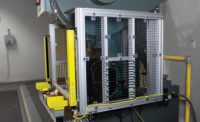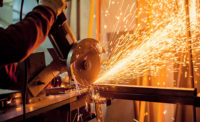We’ve all heard the phrase “what a difference a day makes,” yet when it comes to industrial safeguarding, the concern isn’t days, hours or even minutes. It is the milliseconds it takes for a machine operation to stop after a stop signal is given. That fraction of a second can make the difference between a life-changing injury and a safe machine cycle, the difference between a valued employee going home safe or being taken to the emergency room.
How can plant managers assure determine if a dangerous machine will stop in time? The answer is a portable or built-in Stop Time Measuring (STM) device. An STM is used to determine the total response time from the triggering of a machine’s operating control being activated to the exact moment when a dangerous movement comes to a halt. STMs are mainly used on reciprocating (stroking or cycling) machines, such as mechanical and hydraulic presses or press brakes. With optional accessories, STMs can also be used on machines that rotate, such as lathes, mills, and drills.
Brake cycle stop time
As an example consider the time it takes for a press brake cycle to stop when a finger or hand enters the point-of-operation zone, or the time between when a light curtain is activated and when a drill comes to a complete standstill. To capture that moment down to the millisecond, an STM has a programmed stop signal that releases or actuates a button or other operator-controlled device on the machine during the hazardous portion of the cycle. If a machine has a presence-sensing device, the plane of light is interrupted with a flag that sends a signal to stop the machine. The STM will display either the stopping time of the machine in milliseconds or the calculated safety distance in inches. Besides the machine’s stopping time, minimum safe distance is based on factors such as the reaction time of the safeguarding device and the approach speed of the individual towards the hazard.
Palm buttons, pressure mats, light curtains and other presence-sensing safeguarding devices that do not prevent an operator from reaching into a hazardous area are required by OSHA and ANSI to be located far enough away from the hazardous area that the machine will stop before the operator’s hand or other body part can reach the closest hazard or danger point.
A properly conducted survey requires that at least ten stop time measurements be taken. The mean is then applied to an established formula to calculate the minimum safety distance required for placement of operating controls or safeguarding devices used during production. A record of the measurement can be printed out, or alternatively, the device can be plugged into a PC where the measurements can be recorded and documented.
Here, it is critically important to mention that some machines have a coast down time because a high-pressure, rapid process cannot be stopped immediately without damage to the machine. Guard locking interlocks, which prevent access until a hazardous motion has ceased, may be required in these cases.
Doing the math
In the United States there are two formulas that are used to properly calculate the safety distance. The first, the OSHA formula, is the minimum requirement for the calculation of the safety distance. The second is the ANSI formula, which incorporates additional factors to be considered. Rockford Systems recommends the use of the ANSI system since it is the more comprehensive of the two. The formula is included in ANSI standards B11.19-2010 and Robotic Industries Association (RIA) R15.06-1999 (R2009), as well as CSA Z142-10, Z432-04 and Z434-03.
The ANSI calculation for “safety distance” comprises approach speed, overall stop time and penetration depth factor, although these can vary according to the machine type. For example, the formula used to compute the minimum safety distance (Ds) on mechanical power presses to meet the ANSI B11.1 Press Safety Standard is:
- Ds = K x (Ts + Tc + Tr + Tbm) + Dpf
- K = Hand speed constant (63 inches/second)
- Ts = Stop time of equipment measured at the final control element
- Tc = Response time of the control system
- Tr = Response time of the presence sensing device and its interface
- Tbm = Additional time allowed for the brake monitor to compensate for variations in normal stopping time
- Dpf = The added distance due to the penetration depth factor (MOS).
OSHA 1910.217(c)(3)(iii)(e) and B11.19 are based on the hand speed constant of 63 inches (1.6 meters) per second, to calculate safety distance, that is: Ds (63 inches/second) x Ts. Most STM devices perform calculations internally so the operator doesn’t need to concern themselves with all the details of the math, only the results to act upon.
Periodic validation
Periodic safety distance validation with an STM is required for AOPD systems, light curtains, two-hand control systems, emergency stop devices, pressure-sensitive protective strips or mats, interlocking guards, doors and gates, as well as other safety devices and controls equipment used during production. This is necessary since factors like maintenance, brake wear, and alterations can increase the machine’s stopping time. If a machine stops slower than it did when it was originally commissioned then components will need to be adjusted to continue providing the correct level of safety. Stop time measurement is able to detect changes at an early stage, so that appropriate action can then be taken.
Conclusion
The majority of machine-related accidents happen as a result of a reflex action or when an operator is simply not paying attention. A machine operator may instinctively reach into the machine when there is a jamming issue. Or they will be so focused on a task that they’ll cross the threshold into a hazardous area without being aware of it. In these events, it is critical that a machine's safety devices stop operations before the hazard is reached. In addition, accidents may not be the fault of the operator at all. There are instances where integrators do not program the field of coverage — the area being monitored by the light curtain, for instance — at the proper safety distance and puts the operator unknowingly at danger.
Regularly checking shop machinery with an STM and maintaining a log of the results empowers a company to be proactive in establishing a safety maintenance program. It ensures that safeguarding equipment on machinery works as designed to achieve greater worker safety, productivity and profits.



